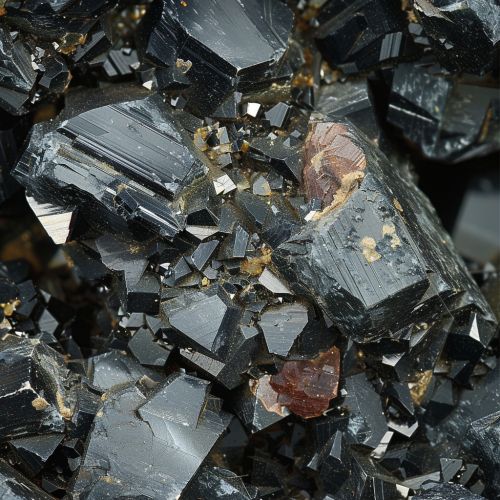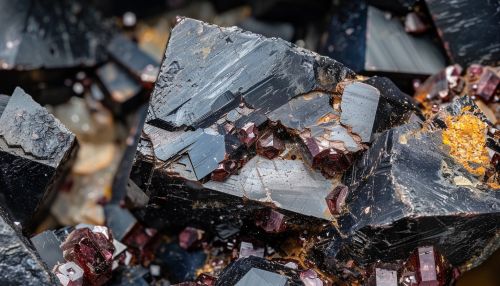Hornblende
Introduction


Hornblende is a complex inosilicate series of minerals (ferrohornblende – magnesiohornblende) found in many types of igneous and metamorphic rocks. It is an important constituent of the amphibole group, which is characterized by its double chain silicate structure. This mineral is typically dark green to black in color and has a vitreous to dull luster. Hornblende is significant in geology for its role in petrology and mineralogy, providing insights into the conditions under which rocks form.
Composition and Structure
Hornblende's chemical composition is highly variable, but it generally includes calcium, sodium, iron, magnesium, and aluminum, with the general formula: (Ca,Na)2-3(Mg,Fe,Al)5(Si,Al)8O22(OH)2. The presence of these elements can vary, leading to different varieties within the hornblende series. The structure of hornblende is based on double chains of silicon-oxygen tetrahedra, which are linked together by cations in octahedral and larger coordination sites.
Chemical Variability
The chemical variability of hornblende is a result of the substitution of different cations within its crystal structure. For instance, iron and magnesium can substitute for each other, leading to the formation of ferrohornblende and magnesiohornblende. Additionally, aluminum can substitute for silicon in the tetrahedral sites, which affects the overall charge balance and stability of the mineral.
Physical Properties
Hornblende exhibits several distinctive physical properties that aid in its identification and study:
- **Color**: Typically dark green to black.
- **Luster**: Vitreous to dull.
- **Hardness**: 5-6 on the Mohs scale.
- **Cleavage**: Two directions at approximately 56 and 124 degrees, characteristic of amphiboles.
- **Density**: 2.9-3.4 g/cm³.
These properties are influenced by the mineral's chemical composition and crystal structure, making hornblende a useful indicator of the conditions under which it formed.
Occurrence and Formation
Hornblende is commonly found in both igneous and metamorphic rocks. In igneous rocks, it is typically present in diorite, andesite, basalt, and gabbro. It forms during the crystallization of magma, often as an early-forming mineral. In metamorphic rocks, hornblende is a key component of amphibolite, a metamorphic rock formed under medium to high-grade metamorphic conditions.
Igneous Rocks
In igneous rocks, hornblende forms as a primary mineral during the cooling and solidification of magma. Its presence can indicate the depth and temperature of the magma chamber, as well as the chemical composition of the parent magma. For example, hornblende-rich rocks are often associated with subduction zone environments, where water-rich magmas are generated.
Metamorphic Rocks
In metamorphic rocks, hornblende forms during the recrystallization of pre-existing minerals under conditions of increased temperature and pressure. It is a common mineral in amphibolite facies metamorphism, where it forms from the alteration of pyroxene and plagioclase in basaltic rocks. The presence of hornblende in metamorphic rocks can provide valuable information about the metamorphic history and conditions of the rock.
Geological Significance
Hornblende plays a crucial role in understanding geological processes and the history of rock formation. Its presence and composition can reveal information about the temperature, pressure, and chemical environment during rock formation. Additionally, hornblende is used in geochronology to date the cooling history of rocks, as it can retain argon and other isotopes used in radiometric dating.
Industrial and Practical Uses
While hornblende itself is not commonly used as an industrial mineral, its presence in rocks can influence their properties and suitability for various applications. For example, hornblende-rich rocks may be used as construction materials, aggregates, and decorative stones. The mineral's durability and resistance to weathering make it a valuable component in these applications.
